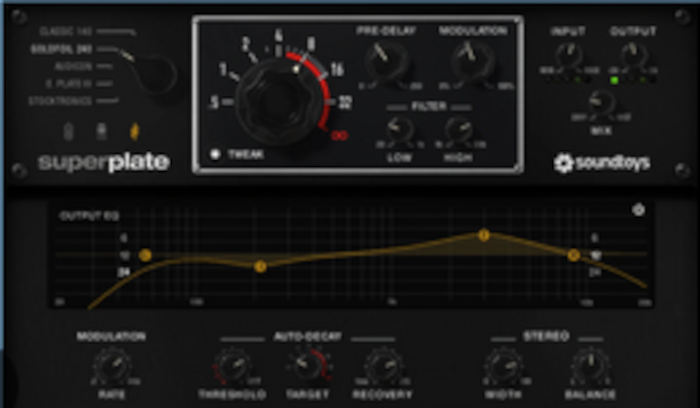Soundtoys has made a significant impact with every release, and their newest plugin, SuperPlate, is no exception. This marks their first new release in over five years, and expectations are high. The question is, just how “super” is this new addition?
In 2017, Soundtoys launched Little Plate, a simple reverb plugin inspired by the classic EMT 140 plate reverb. Like other ‘little’ plugins in the Soundtoys lineup, it was initially released for free and was meant to whet users’ appetites for a more comprehensive version. However, Little Plate quickly became a fan favorite in its own right. Despite this, Soundtoys promised a more advanced, feature-rich version would come in due time. Fast forward several years, and that promise has been fulfilled with SuperPlate, which was unveiled at the 2024 NAMM Show. While at first glance, SuperPlate may look like a natural extension of Little Plate, with more plate emulations and a pre-delay option, there’s a lot more under the hood.
SuperPlate is available as a standalone plugin and as part of the Soundtoys 5.4 bundle. It supports all the major native formats and, like all Soundtoys plugins, is authorized through iLok. Additionally, SuperPlate can be used within the Soundtoys EffectRack plugin, allowing it to be part of a multi-effect chain. For instance, you can combine it with EchoBoy to simulate a tape delay feeding into a plate reverb. The entire effect chain can then be saved as a single plugin preset, making it highly versatile and customizable for any project.
Little Plate was initially based on the EMT 140, a classic reverb that used a steel plate to create its signature sound. Soundtoys tested several EMT 140 units while developing Little Plate but aimed to capture the essence rather than make an exact replica. In SuperPlate, they’ve expanded that same approach to include four additional classic plate models. Alongside the EMT 140, you’ll find the EMT 240, which uses gold foil instead of steel for a more compact design and a different tonal character. There are also emulations of two popular American plates from the 1970s and ’80s, along with a rare Swedish model, the Stocktronics RX4000. All five models offer extended decay times, from as short as half a second to infinite decay, giving users maximum flexibility. The new pre-delay feature also allows delays of up to 250 milliseconds, opening the door to creative reverb effects.
Reverb plates work by amplifying the input signal and feeding it into a driver that excites the plate. In early EMT models, this amplification was done using tube (valve) technology, while later models adopted solid-state amplifiers, each contributing a distinct character. The tube amps tend to sound warmer and more colorful, particularly when overdriven, while the solid-state amps are cleaner and quieter. SuperPlate allows users to choose between both amplifier types or a clean digital signal path. By increasing the plugin’s input gain, you can drive the amp model into compression, adding warmth and color to the reverb tail.
Like most of Soundtoys’ advanced plugins, SuperPlate includes a “Tweak” button that reveals a set of additional controls. These include a two-band EQ that sits at the output stage of the plugin, and high-pass and low-pass filters for more precise tone shaping. These filters can be adjusted between 6, 12, and 24 dB/octave slopes for greater control over the reverb’s frequency response. The tweak panel also features modulation rate adjustments, stereo width controls, and the innovative Auto-Decay function.
Auto-Decay provides an alternative to traditional ducking, where the reverb decay time is dynamically reduced when the input signal exceeds a certain threshold. This makes it ideal for vocal applications where you want the reverb to back off while the vocal is present and return between phrases. You set a decay time threshold, and when the input signal crosses that threshold, the reverb’s decay is shortened. Once the signal drops back below the threshold, the decay time returns to its original setting. It’s an intuitive way to keep reverb in check without sacrificing richness or clarity.
In most mixing situations, SuperPlate is not necessarily an experimental tool, though its infinite decay settings allow for some creative exploration. Its primary goal is to serve as a high-quality plate reverb for everyday mixing, and in that regard, it excels. Soundtoys has struck a balance between usability, flexibility, and sonic quality. The controls are easy to understand, and there’s enough range to tailor the reverb to fit any mix, but not so much complexity that it feels overwhelming.
Each of the five plate models in SuperPlate has its own character. The EMT 140 remains the go-to for many applications, delivering a sound that works across a wide variety of material. The EMT 240 has a more compact, boxy sound, which can be great for situations where you don’t need as much space or floatiness. The American plates offer bright, brash tones with strong midrange presence, while the Stocktronics RX4000 is brighter and splashier. In all cases, the amp modeling adds another layer of depth, providing a subtle yet effective way to shape the reverb’s color.
For those who believe you can’t live by plate reverb alone, SuperPlate might just change your mind. It’s a plugin that more than lives up to its name.


0 Comments